The Rane Four is Rane’s flagship performance controller for Serato, and arguably the best Serato controller out there, its main competition up until 2023 being the now discontinued Pioneer DJ DDJ-1000SRT, which had far fewer features, especially around control of real-time stems.
Watch the video
In this video, I talk you in detail through the similarities and differences between these units.
But with the release of the Pioneer DJ DDJ-FLX10, Pioneer DJ now also has a four-channel performance controller in that part of the market, which also leans heavily towards DJing with stems. So in this article and video, we’ll compare the controller and help you decide which may be best for you as a Serato user.
Read this next: Pioneer DJ DDJ-FLX10 Review
Pioneer DJ DDJ-FLX10 Vs Rane Four
The basics
Both are performance controllers, and they both sound great, with good audio interfaces, headphones amps, etc.
That also means they’ve got everything you’d expect on a high-end controller, features-wise: Four mixer channels, four decks (two on each side, layered), really good RGB pads, high-end performance features like beat jump, slip mode, censor mode, auto and manual looping, comprehensive library navigation features, and so on.
Get your FREE Comparison Chart
See how these popular controllers stack up against the competition with this handy chart comparing all the key features. Click here to get your chart now.
Here, there are only minor differences: The FLX10 has a tempo reset button on the pitch control, the Rane Four goes for a centre click; the Rane Four has Pitch Bend buttons, which the FLX10 lacks; the Rane Four has slightly better Beat Jump options.
But when it comes to the basic DJing controls, these are small things, and both units are highly specified. The only real thing we’d like to have seen on the DDJ-FLX10 that is on the Rane Four is a headphones split cue, curiously missing from the former.
Also probably worth pointing out on the Rane Four, the sampler can be routed to the fourth mixer channel for applying effects etc, something not possible on the FLX10.
Appearance & build quality
The Rane is all-metal, whereas the Pioneer unit is a mixture of metal and plastic. However, both are built to a high, professional standard, from brands with proven reliability.
The knobs, buttons, faders and so on are all high quality, and both have scratch performance-standard crossfaders.
Learn to DJ with us: The Complete DJ Course
The DDJ-FLX10 has an external power brick, whereas the Rane Four has an onboard transformer and standard IEC “kettle” socket and lead – we much prefer the latter.
The Rane Four is a little wider, but not as deep as the Pioneer, and the Pioneer sits lower on the table due to the Rane’s big, turntable-like feet. Both have an awful lot of knobs, buttons and faders, but to our eyes the Rane looks a little less busy than the Pioneer.
Serato compatibility & suitability
Both units unlock Serato DJ Pro, and come with the necessary Pitch ‘n Time Expansion Pack needed for creative performance DJing. Both are also DVS compatible, although you’d need to subscribe to or buy the additional software version to use that, in both cases.
A big difference between the units is that the Rane is exclusively for Serato DJ Pro, whereas the Pioneer is primarily a controller for Rekordbox, with Serato considered a secondary software.
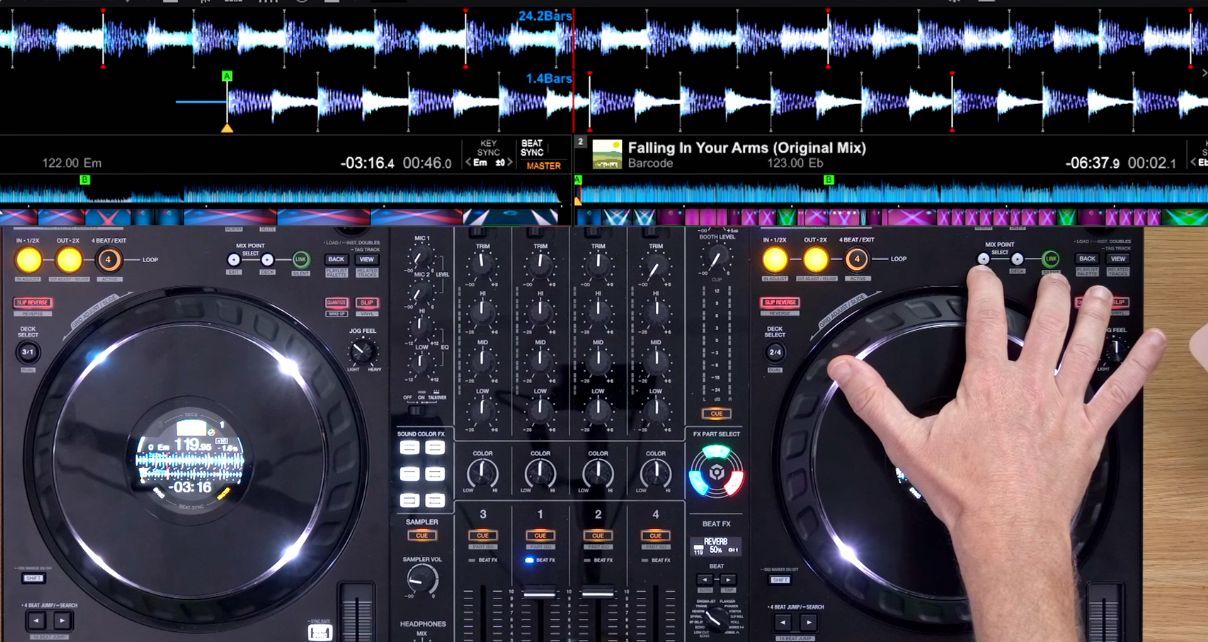
That means some of the labelling is wrong, notably on the pads, and also notably, the “Mix Point Link” function – which is a selling point of this unit for Rekordbox – doesn’t work at all with Serato. There’s a bit of a learning curve for Serato users because of all of this.
External inputs & outputs
Both are similarly specified here, with pro inputs and outputs, and two USBs for two laptops.
The main differences are: The DDJ-FLX10 has external inputs on all four channels, but the Rane Four only has them on channels 3 and 4; the DDJ-FLX10’s second mic input is TRS only, whereas both mic inputs on the Rane Four are combi (TRS and XLR) sockets; and the DDJ-FLX10 has a DMX output for direct lighting control – unique from any other DJ controller (although useless with Serato).
Note that the USBs on the DDJ-FLX10 are USB-C; they’re the older, more usual USB-B on the Rane Four.
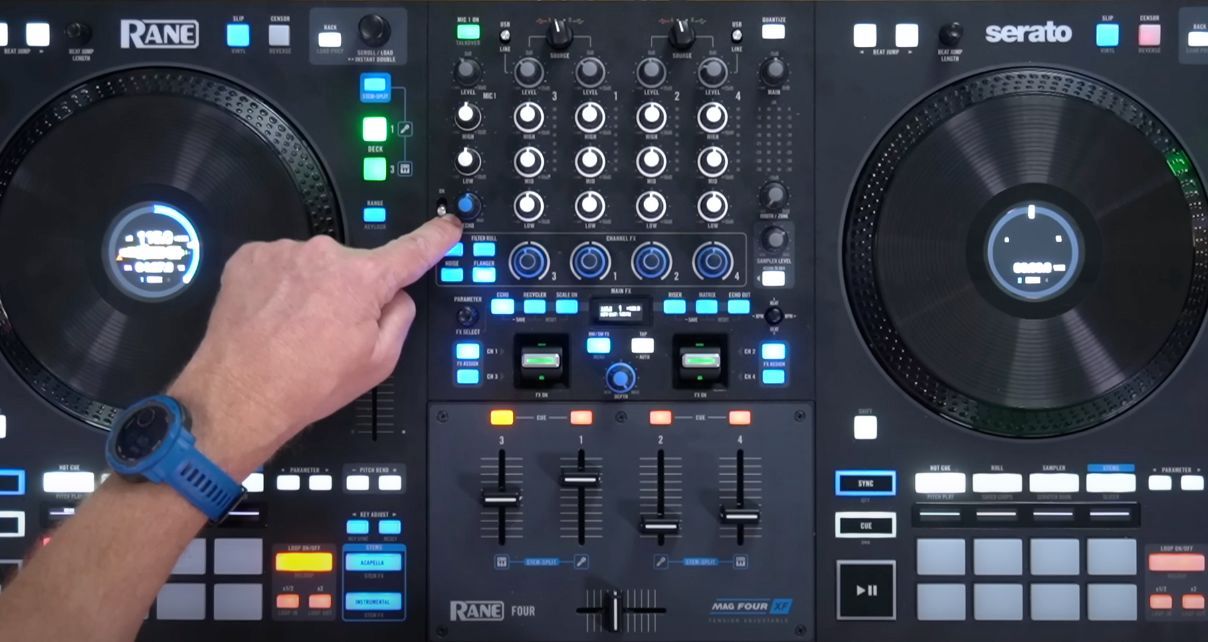
Also note that the mics have independent EQs on the Rane Four; the EQs are combined on the DDJ-FLX10 (and while we’re talking about the mics, there’s a mic echo on the Rane Four, no mic effects at all on the DDJ-FLX10 – although you can send the mic through the Beat FX should you wish).
With both units, it is possible to add extra decks. You can add turntables (you’ll need to own, subscribe to or pay to upgrade for one of the Serato DVS software options), or you can add extra software control decks, such as the Rane Twelve motorised turntable controller, or the Denon DJ LC6000 static jogwheel controller.
Screens
Both have screens in their jogwheels, showing waveform information for the chosen deck, and other deck info. The FLX10 has an additional mode for showing parallel waveforms (not possible on the Rane Four), and can show track artwork and your choice of DJ logo.
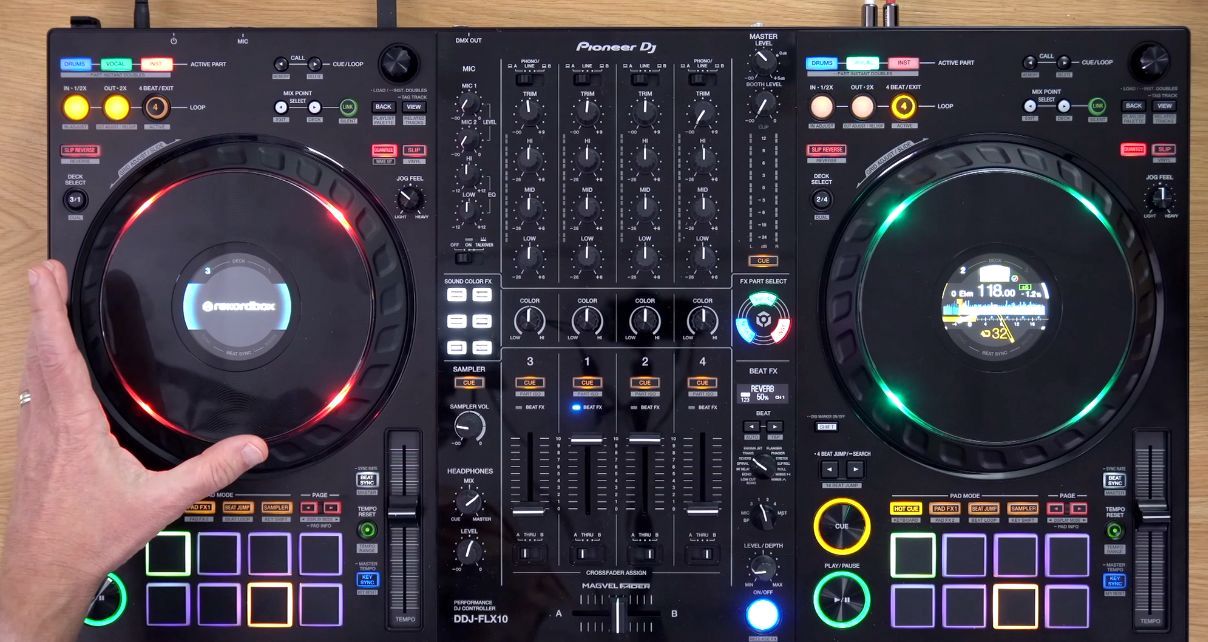
In addition, the Rane Four has eight small OLED screens, positioned above the performance pads, that show information about the pad settings. A similar feature is available as a “heads up” display on the FLX10’s in-jog screens.
Overall, they both have their strengths and weaknesses in this department – but seeing as you have a nice big laptop screen right in front of you too, for us this is no deal-breaker with either unit. On-unit screens are flashy, but ultimately a luxury.
Jogwheels
Both units have static jogwheels, the DDJ-FLX10’s being standard club jogwheels similar to those found on the Pioneer DJ CDJ-3000, complete with mechanical tension knobs, the Rane Four’s being lower, wider and without tensioners.
Both are great to use, although they do feel very different – it’s a personal choice thing here.
Aproach to Serato Stems
Stems is a headline feature for both of these controllers, but they approach stems differently.
Read this next: Using Stems In Serato DJ Pro – All You Need To Know
The DDJ-FLX10 uses three dedicated buttons for the three stems it offers you (drums, vocals, instruments). The Rane Four offers two dedicated buttons, Acapella and Instrumental. However, the Rane Four also has Serato’s standard pad mode for Stems, giving you four stems instead of three (Drums, Bass, Melody, Vocals). Note that you can access this pad mode on the DDJ-FLX10, too, but it means sacrificing one of the other pad modes.
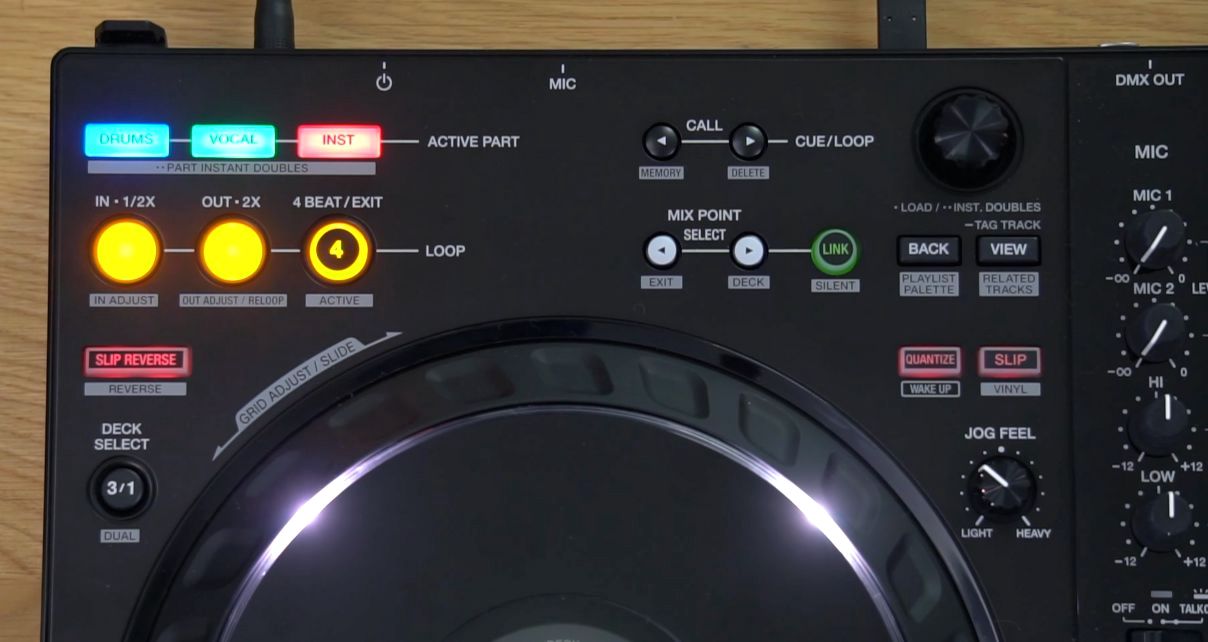
But the differences don’t end there. Let’s dive deeper into this headline feature…
Stems doubles
Both the DDJ-FLX10 and the Rane Four have a version of Stems doubles (quickly splitting a track between two decks as it’s playing, with one stem on one deck and the rest on the other).
With the Rane Four, it defaults to splitting the acapella from the rest of the track, which makes sense as it is the most common use case here, although you can alter this easily with the pads. With the DDJ-FLX10, you can choose what to instantly double at the point of triggering the feature, making it slightly more flexible.
Also on the FLX10, you can choose to instant double the track to either the left or right decks, or the other layer controlled by the same deck – something not possible on the Rane Four, which stem instant doubles to the other layer on the same deck by default.
Using stems on the mixer EQs
With the DDJ-FLX10, there is a “Part ISO” mode that lets you quickly switch out the low, mid and high EQs of a channel for drums, instruments and vocals, so you can fade the stems in and out of the mix rather than just turn them on and off.
The Rane Four has no such setting, so you’re limited to turning the stems on and off – or if you want more control, using instant doubles to put a stem or stems onto a different channel.
Adding effects to individual stems
The DDJ-FLX10 has a feature called “FX Part Select” that lets you choose one or two of the stems to be fed into the Sound Color FX and the Beat FX. When engaged, both of these effects will only affect the chosen stem or stems.
The setting works across both effect types at once (there’s no either/or) and across all tracks you choose to use the effects with, at once. Overall it’s immediate and fun, and with the Rane Four, there is no such feature.
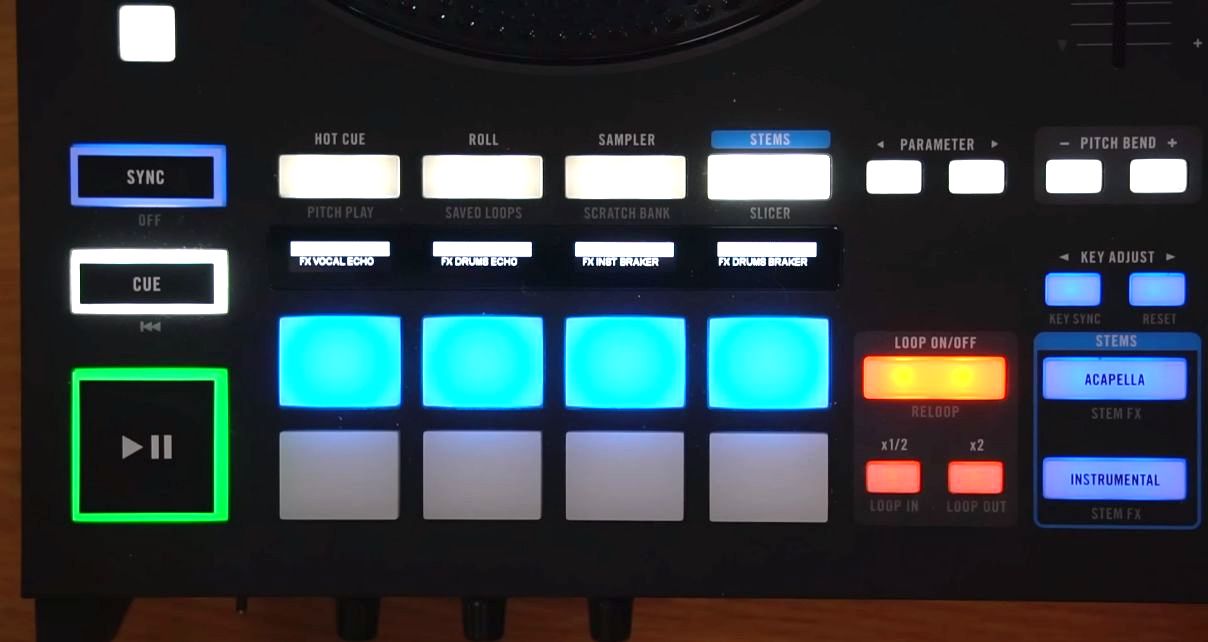
However, Serato offers four “stems FX” that are cooler ways to mix in and out of the various stems, using things like echoes and vinyl effects. These are accessed using the bottom four pads of the Stems pad mode, and are also fun to use. (Optionally, they’re available on the DDJ-FLX10 too, at the expense of another pad mode.)
Hardware and software effects
Speaking of effects, the Rane Four has four channel FX (Filter, Filter Roll, Noise, Flanger), the DDJ-FLX10 has six (Filter, Space, Dub Echo, Crush, Pitch, Noise). However, on the Rane Four these are Serato software FX, but on the Pioneer DJ unit, they are hardware effects, meaning they work independently of the software. (On the Rane Four, if Serato isn’t enabled, those knobs revert to a single filter effect for channels 3 and 4.)
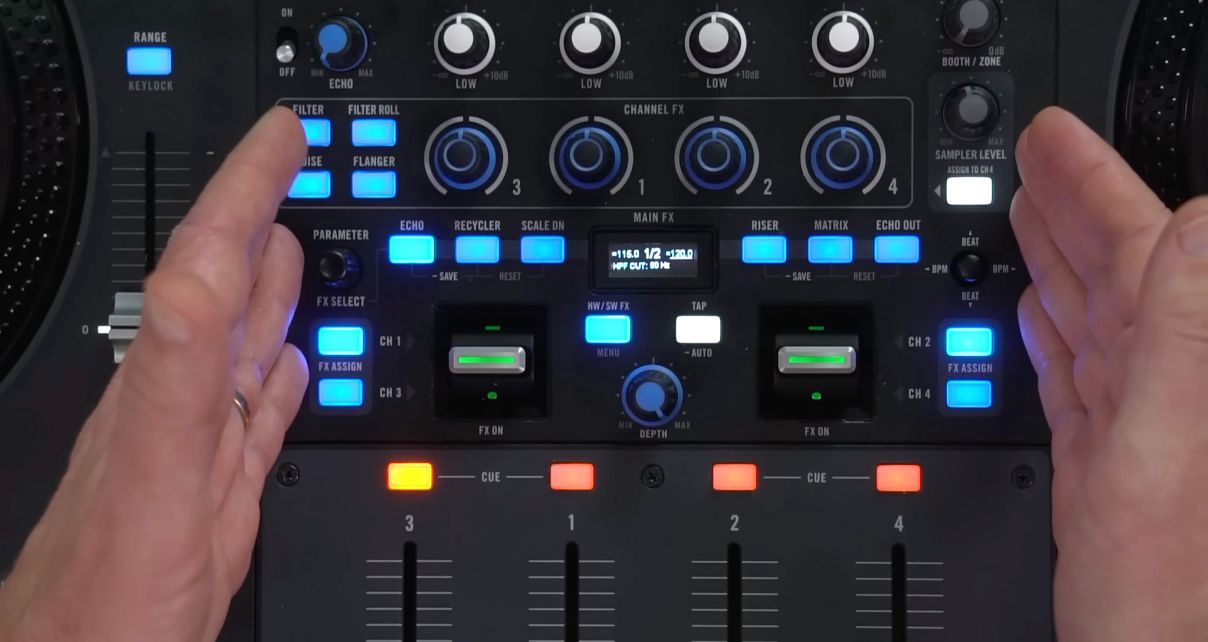
The Rane Four has 22 main hardware effects, whereas the DDJ-FLX10 has 14 such effects. The layout and accessibility of these effects follows the “club mixer style” on the DDJ-FLX10, but the “scratch mixer style” (ie with paddles) on the Rane Four. You’ll prefer one or the other.
Both units have a small screen to display useful information about the selected effect. Overall we feel the hardware effects on the DDJ-FLX10 sound a bit better.
The Rane Four can additionally control Serato’s built-in effects with the same controls used to access the hardware effects; there is no control at all over Serato’s built-in effects with the DDJ-FLX10.
So that brings us to the end of our feature comparison – the next question is, which to choose?
Which is right for you?

Go for the Rane Four if…
- You want the closest mapping to Serato’s features, including Stems – As this is a Serato-only controller, it works better with Serato overall than the DDJ-FLX10, and the Stems mapping makes the most sense for the way Serato Stems work, too.
- You like the ideal scratch mixer layout – Particularly the paddle FX
- You’re thinking of pairing with the Rane Twelves – It’ll look better, as the units are designed to sit together
Go for the Pioneer DJ DDJ-FLX10 if…
- You think you may want to use Rekordbox as well as Serato – The fact that it unlocks both is great added value
- You prefer your DJ gear to look and feel like club gear – It’s always been a selling point of the Pioneer DDJ-1000s and now the DDJ-FLX10.
- You prefer the way Pioneer DJ has implemented Serato Stems – in that case, here you’re getting the best of both worlds, because you’re getting Pioneer’s thinking but Serato’s sound quality (and you can still use Serato Stems on the pads if you wish)
DJ like a pro using ANY gear: The Complete DJ Course
Finally…
Truth is that these are both excellent controllers, offering an unprecedented level of control over Serato, whichever one you go for. From this article though, you’ll hopefully have formed a much better personal opinion about which one may be right for you.
Get your FREE Comparison Chart
See how these popular controllers stack up against the competition with this handy chart comparing all the key features. Click here to get your chart now.
If you have any questions, comments or feedback – or if you think you’ve spotted something we’ve missed – do let us know in the comments.



